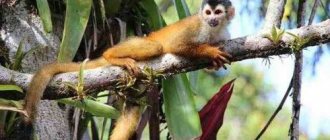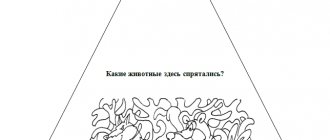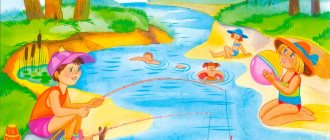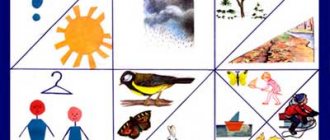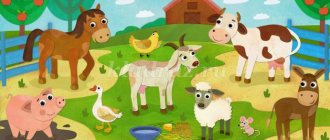Distance learning for preparatory group children on the lexical topic “Animals of hot countries”
Stage 2.
Draw a small oval a little higher - the head of a giraffe.
Stage 3.
We connect the torso and head with two parallel lines. The result is the neck of an animal.
Stage 4.
Drawing the legs of a giraffe.
Stage 5. We draw the ear and horns of a giraffe.
Stage 6.
Let's start coloring 9coloring materials of your choice: paints, pencils, etc.)
Consultation for parents
Computer: pros and cons
Probably, most parents are now faced with the computer boom that almost all children are exposed to. Today, the appeal of the computer cannot be compared with either the TV or any other activity. The magic of computer games has now captured almost the entire young generation all over the world. Parents are most often concerned about the impact of the computer on vision and the harmful effects of radiation, as well as the possibility of getting a future computer fan in their own child, immersed in an artificial virtual world that takes him away from real life.
What picture do we see in almost all families where there is a computer? When a child comes home, he rushes to the computer, sluggishly kicking away from our persistent attempts to feed his modern child lunch. And endless games until the evening. Sound familiar?
Believe me, you are not alone.
Many parents, having bought a computer for their child, breathe a sigh of relief, because... this, to some extent, solves the problems of the child’s free time, his education (according to educational programs) or development (according to developmental programs), as well as receiving a charge of positive emotions from his favorite game, etc.
A small child is a very sensitive organism, all of whose physiological systems, including those necessary for successful interaction with a computer, develop in preschool and primary school age.
Unlimited computer activities against the backdrop of an ever-increasing information load can accelerate unfavorable changes in a child’s well-being and affect his psyche. We advise parents to pay attention to the following points.
Buy a good quality computer and display for your child, do not skimp on your children’s health.
Place the computer on a table in the corner of the room, with its back to the wall, in a well-lit area, but so that there is no glare on the screen.
Organize your child's workspace correctly. Choose furniture that suits his height.
For children 115–130 cm tall, the recommended table height is 54 cm, the chair seat height (necessarily with a hard back) is 32 cm. The distance between the child and the display is at least 50–70 cm (the further, the better). The child’s posture is straight or slightly tilted forward, with a slight tilt of the head, the landing is stable. The space between the body and the edge of the table is at least 5 cm.
Plan – summary of GCD using ESM in the preparatory group “Animals of hot countries”
Lesson summary for the preparatory group “Wild animals of hot countries”
Goals:
Consolidating ideas about wild animals of hot countries, their appearance, lifestyle and habits.
Fostering love and respect for nature.
Objectives of using ESM
: 1. Getting to know the animals of hot countries. 2. Expanding the horizons of children. 3. Development of cognitive and research activities. 4. Development of attention and visual perception. 5. Expansion of vocabulary. 6. Instilling in children love and respect for nature.
Equipment:
magnetic board, pictures for the magnetic board, a set of magnets, a diagram for writing descriptive stories, electronic educational resources: presentation “Animals of hot countries,” computer. Progress of the lesson.
1. Organizational moment. (Announcing the topic of the lesson. Creating an emotionally positive background.) Educator. If it's cold, guys, here are some hot riddles for you. The warmest continent is picturesque and large. Many lions and monkeys live here among the savannas. (Africa).
2. Conversation about animals of hot countries. (Development of dialogical speech.) Examination with children of pictures of wild animals of hot countries. The teacher tells the children about what the animals of the hot countries where they live eat, and what their cubs are called. Characteristics of the appearance of animals are given, children's attention is drawn to parts of the animal's body (torso, head, tail, horns, hooves, shell, etc.). 3. Didactic exercise “Select, name, remember.” - Complete the sentences (select and name as many feature words, action words as possible), for example, elephant (which one?) - big, strong; tiger (what is he doing?) - growls, hunts.
4. Compilation of descriptive stories about animals of hot countries according to the scheme. The teacher places a diagram of a story about an animal on a magnetic board. Educator. Now we will compose descriptive stories about animals. First, you will say what the animal is called, where it lives, what size and color it is, what features are in the structure of the body, what its cubs are called, how it speaks, what it eats. (Several description stories are compiled about the animals chosen by the children). 5. Physical education minute.
Finger gymnastics “Where the sparrow dined.”
-Where did you have lunch, sparrow? (Children wave with crossed palms.) - In the zoo with the animals. (Palms depict an opening mouth.) - First I had lunch behind bars with a lion. (For each name of the animal, one finger is bent, first on the left, then on the right hand.) I refreshed myself at the fox’s and drank some water at the walrus’s. I ate carrots from an elephant. I ate millet with the crane. I stayed with a rhinoceros and ate a little bran. I attended a feast with tailed kangaroos. I was at a festive dinner at the shaggy bear's place. And a toothy crocodile almost swallowed me. (Again they depict the opening mouth of the animal).

